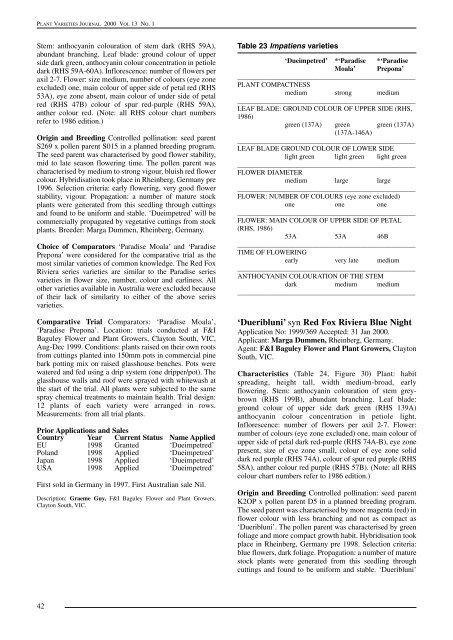53. Volume 13- Number 1 - IP Australia
53. Volume 13- Number 1 - IP Australia
53. Volume 13- Number 1 - IP Australia
Create successful ePaper yourself
Turn your PDF publications into a flip-book with our unique Google optimized e-Paper software.
PLANT VARIETIES JOURNAL 2000 VOL <strong>13</strong> NO. 1<br />
Stem: anthocyanin colouration of stem dark (RHS 59A),<br />
abundant branching. Leaf blade: ground colour of upper<br />
side dark green, anthocyanin colour concentration in petiole<br />
dark (RHS 59A-60A). Inflorescence: number of flowers per<br />
axil 2-7. Flower: size medium, number of colours (eye zone<br />
excluded) one, main colour of upper side of petal red (RHS<br />
53A), eye zone absent, main colour of under side of petal<br />
red (RHS 47B) colour of spur red-purple (RHS 59A),<br />
anther colour red. (Note: all RHS colour chart numbers<br />
refer to 1986 edition.)<br />
Origin and Breeding Controlled pollination: seed parent<br />
S269 x pollen parent S015 in a planned breeding program.<br />
The seed parent was characterised by good flower stability,<br />
mid to late season flowering time. The pollen parent was<br />
characterised by medium to strong vigour, bluish red flower<br />
colour. Hybridisation took place in Rheinberg, Germany pre<br />
1996. Selection criteria: early flowering, very good flower<br />
stability, vigour. Propagation: a number of mature stock<br />
plants were generated from this seedling through cuttings<br />
and found to be uniform and stable. ‘Dueimpetred’ will be<br />
commercially propagated by vegetative cuttings from stock<br />
plants. Breeder: Marga Dummen, Rheinberg, Germany.<br />
Choice of Comparators ‘Paradise Moala’ and ‘Paradise<br />
Prepona’ were considered for the comparative trial as the<br />
most similar varieties of common knowledge. The Red Fox<br />
Riviera series varieties are similar to the Paradise series<br />
varieties in flower size, number, colour and earliness. All<br />
other varieties available in <strong>Australia</strong> were excluded because<br />
of their lack of similarity to either of the above series<br />
varieties.<br />
Comparative Trial Comparators: ‘Paradise Moala’,<br />
‘Paradise Prepona’. Location: trials conducted at F&I<br />
Baguley Flower and Plant Growers, Clayton South, VIC,<br />
Aug-Dec 1999. Conditions: plants raised on their own roots<br />
from cuttings planted into 150mm pots in commercial pine<br />
bark potting mix on raised glasshouse benches. Pots were<br />
watered and fed using a drip system (one dripper/pot). The<br />
glasshouse walls and roof were sprayed with whitewash at<br />
the start of the trial. All plants were subjected to the same<br />
spray chemical treatments to maintain health. Trial design:<br />
12 plants of each variety were arranged in rows.<br />
Measurements: from all trial plants.<br />
Prior Applications and Sales<br />
Country Year Current Status Name Applied<br />
EU 1998 Granted ‘Dueimpetred’<br />
Poland 1998 Applied ‘Dueimpetred’<br />
Japan 1998 Applied ‘Dueimpetred’<br />
USA 1998 Applied ‘Dueimpetred’<br />
First sold in Germany in 1997. First <strong>Australia</strong>n sale Nil.<br />
Description: Graeme Guy, F&I Baguley Flower and Plant Growers,<br />
Clayton South, VIC.<br />
Table 23 Impatiens varieties<br />
‘Dueimpetred’ *‘Paradise *‘Paradise<br />
Moala’ Prepona’<br />
____________________________________________________<br />
PLANT COMPACTNESS<br />
medium strong medium<br />
____________________________________________________<br />
LEAF BLADE: GROUND COLOUR OF UPPER SIDE (RHS,<br />
1986)<br />
green (<strong>13</strong>7A) green green (<strong>13</strong>7A)<br />
(<strong>13</strong>7A-146A)<br />
____________________________________________________<br />
LEAF BLADE GROUND COLOUR OF LOWER SIDE<br />
light green light green light green<br />
____________________________________________________<br />
FLOWER DIAMETER<br />
medium large large<br />
____________________________________________________<br />
FLOWER: NUMBER OF COLOURS (eye zone excluded)<br />
one one one<br />
____________________________________________________<br />
FLOWER: MAIN COLOUR OF UPPER SIDE OF PETAL<br />
(RHS, 1986)<br />
53A 53A 46B<br />
____________________________________________________<br />
TIME OF FLOWERING<br />
early very late medium<br />
____________________________________________________<br />
ANTHOCYANIN COLOURATION OF THE STEM<br />
dark medium medium<br />
____________________________________________________<br />
‘Dueribluni’ syn Red Fox Riviera Blue Night<br />
Application No: 1999/369 Accepted: 31 Jan 2000.<br />
Applicant: Marga Dummen, Rheinberg, Germany.<br />
Agent: F&I Baguley Flower and Plant Growers, Clayton<br />
South, VIC.<br />
Characteristics (Table 24, Figure 30) Plant: habit<br />
spreading, height tall, width medium-broad, early<br />
flowering. Stem: anthocyanin colouration of stem greybrown<br />
(RHS 199B), abundant branching. Leaf blade:<br />
ground colour of upper side dark green (RHS <strong>13</strong>9A)<br />
anthocyanin colour concentration in petiole light.<br />
Inflorescence: number of flowers per axil 2-7. Flower:<br />
number of colours (eye zone excluded) one, main colour of<br />
upper side of petal dark red-purple (RHS 74A-B), eye zone<br />
present, size of eye zone small, colour of eye zone solid<br />
dark red purple (RHS 74A), colour of spur red purple (RHS<br />
58A), anther colour red purple (RHS 57B). (Note: all RHS<br />
colour chart numbers refer to 1986 edition.)<br />
Origin and Breeding Controlled pollination: seed parent<br />
K2OP x pollen parent D5 in a planned breeding program.<br />
The seed parent was characterised by more magenta (red) in<br />
flower colour with less branching and not as compact as<br />
‘Dueribluni’. The pollen parent was characterised by green<br />
foliage and more compact growth habit. Hybridisation took<br />
place in Rheinberg, Germany pre 1998. Selection criteria:<br />
blue flowers, dark foliage. Propagation: a number of mature<br />
stock plants were generated from this seedling through<br />
cuttings and found to be uniform and stable. ‘Dueribluni’<br />
42

















